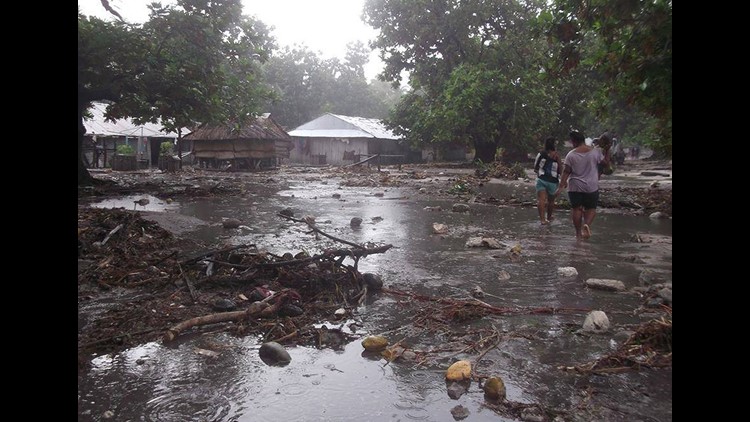Aid workers described scenes of extensive devastation in the capital Port Vila and expressed fears of even more destruction farther afield.
At least six people have been confirmed dead. But communications with many of the 80-plus islands in the archipelago are down, so the fear is that the toll will climb as more information emerges. The confirmed deaths, reported by the National Disaster Management Office, are just from Port Vila.
The storm flattened homes, scattered trees across roads and inflicted damage on key buildings that are meant to serve as safe havens, like the hospital, schools and churches.
“It’s becoming increasingly clear that we are now dealing with worse than the worst case scenario in Vanuatu,” said Helen Szoke, executive director in Australia for the aid group Oxfam. “This is likely to be one of the worst disasters ever seen in the Pacific.”
At least 90 percnet of housing in Port Vila has been badly damaged, parts of the hospital are flooded and the state mortuary took a hit, Oxfam said.
Trees like ‘snapped toothpicks’
For most of a 24-hour period between Friday and Saturday, the cyclone pummeled the South Pacific nation, where some 260,000 people live, many in flimsy homes built of thatch.
It is unclear how many thousands of people have been displaced by the massive storm that bore the might of a Category 5 hurricane when it made landfall.
Relief workers are raising concerns about a lack of clean water and sanitation for the many people left homeless.
Aid has started to trickle in. The Australian government said a first contingent of officials and supplies arrived in Port Vila around noon Sunday and more flights were expected to follow.
Tom Perry of the aid group CARE International, who arrived on one of the first Australian military flights into Port Vila, told CNN the damage there was “very significant” with trees that looked like “snapped toothpicks.”
‘Like a bomb has gone through’
“It’s like a bomb has gone through,” said journalist Michael McLennan, who lives in Port Vila. “It’s really quite apocalyptic.” Most buildings in the capital were destroyed or damaged, he told CNN on Sunday morning. Many roads were blocked by fallen trees or power lines.
The main objective now is to get disaster response teams into Vanuatu and kick-start the humanitarian operation, Sune Gudnitz, regional head for U.N. aid agency OCHA, told CNN from Fiji, about 600 miles away.
Only a little information has so far trickled out from beyond the capital, which is on the island of Efate, but Gudnitz said that he fears the worst based on the destruction seen in the capital.
“Unfortunately, the more that comes out, the worse it looks,” he said.
Isolated communities
Vanuatu’s remote location adds to the challenges the international response faces. Port Vila is more than 1,100 miles northeast of Brisbane on Australia’s east coast, and some 1,375 miles north of Auckland, the closest city in New Zealand.
Reaching the more isolated communities will also take time. Vanuatu’s archipelago — comprising 83 small islands, about 65 of them inhabited — is roughly 530 miles long.
People away from the capital live much like their ancestors did generations ago. Homes are built of weaker materials, including straw and corrugated steel that stood little chance against Pam’s raging winds.
Storm churning near New Zealand
Pam isn’t done yet. It’s expected to pass close to New Zealand’s North Island Sunday and Monday, though with much less ferocity than it brought to Vanuatu.
Wind and rain were building over the northern part of the country on Sunday afternoon, the Meteorological Service of New Zealand said.
New Zealand’s official weather agency has forecasts up to 8 inches of rain and 100 mph wind gusts in parts of the North Island.
Pam is the South Pacific’s second strongest cyclone since record-keeping began in 1970. And it’s the strongest of any type since Super Typhoon Haiyan smashed into the Philippines in 2013, killing more than 6,000 people.
How to help
Aid workers on the ground are reporting massive destruction. The Australian Red Cross said via Twitter that “humanitarian needs will be enormous. Many people have lost their homes. Shelter, food and water (are) urgent priorities” in Port Vila.
Save the Children has launched an emergency response page for donations to help children and their families.
If you would like to contribute to the efforts of those in place to help the victims of this storm, please check out one of the groups listed below. They are all poised and ready to start helping once it is safe to do so.
— Australian Red Cross
— CARE International
— Save the Children
— Oxfam Australia
— World Vision
— Samaritan’s Purse
— ADRA
— UNICEF New Zealand
— UNICEF Australia
— UNICEF International



